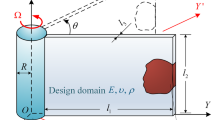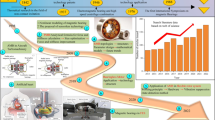Abstract
Rotor assembly is a core tache in the whole process of aero-engine manufacturing. It is critical to ensure the excellent concentric performance of the overall assembly to satisfy the requirements of vibration-free and noise-free. However, assembly deviation is unavoidable due to the parts’ geometrical error, and it is difficult to meet the target requirement by manual adjustments in practical production. Three-dimensional deviation modeling is a feasible means to analyze assembly precision and optimize assembly process. Existing methods can construct the position and pose of geometric deviations in space but unable to handle the problem of surface morphology expression. This will cause a great loss of physical constraints and deviation information to the reliability of the analysis results. This article focuses on two points: one is the deviation expression for morphology error, and the other is the deviation propagation for multistage rotational optimization. Firstly, vectorization method of non-line contour was introduced to characterize the morphology feature of mounting edge, the core idea of which was that multiple vectors were used to approximate the contour curve; secondly, the similarity of each group of corresponding vectors in source features and target features was calculated and evaluated, to realize morphology evaluation and matching; next, combining the multistage revolving characteristics of rotors, the deviation propagation model was established for optimum mounting angle searching. Finally, this contour vectorization-based assembly technique was demonstrated by an example application of four-stage rotors assembly. Experimental results show that compared with traditional deviation modeling method, the overall concentric performance has improved 26.6% by using the suggested method, and the optimal installation angles (2π/3 rad, πrad, and π/3 rad) can be easily solved. It proves that contour vectorization-based assembly technique is feasible and of high practicability. It can be integrated with computer systems to propose assistance for operators in assembling stage.













Similar content being viewed by others
References
Pan G, Chen W, Wang M (2019) A review of parallel kinematic mechanism technology for aircraft assembly. Acta Aeronautica et Astronautica Sinica 40(1):522572
Jayaweera N, Webb P, Johnson C (2010) Measurement assisted robotic assembly of fabricated aero-engine components. Assem Autom 30(1):56–65
Zhang H, Li X, Jiang L, Yang D, Chen Y (2019) A review of misalignment of aero-engine rotor system. Acta Aeronautica et Astronautica Sinica 40(6):022717
Zhang Z, Guo J, Hong J, Sun Y (2021) Application study of intelligent algorithms for prediction and phase optimization of assembly eccentricity of aero-engine high pressure rotor. J Xi’an Jiaotong Univ 55(2):47–54
Chen H, Jin S, Li Z, Lai X (2014) A comprehensive study of three dimensional tolerance analysis methods. Comput Aided Des 53:1–13
Cao Y, Liu T, Yang J (2018) A comprehensive review of tolerance analysis models. Int J Adv Manuf Technol 97:3055–3085
Rivest L, Fortin C, Morel C (1994) Tolerancing a solid model with a kinematic formulation. Comput Aided Des 26(6):465–476
Fleming A (1988) Geometric relationships between tolerance features. Artif Intell 37(1–3):403–412
Portman V, Weill R (1996) Modelling spatial dimensional chains for CAD/CAM applications. In: Computer-aided tolerancing. Cham: Springer p 71–85
Marziale M, Polini W (2011) Review of variational models for tolerance analysis of an assembly. Proc Inst Mech Eng, Part B J Eng Manuf 225(B3):305–318
Cai W, Hu S, Yuan J (1997) A variational method of robust fixture configuration design for 3-D workpieces. J Manuf Sci Eng 119:593–602
Gao J, Chase K, Magleby S (1998) General 3-D tolerance analysis of mechanical assemblies with small kinematic adjustments. IIE Trans 30(4):367–377
Lafond P, Laperrie`re L (1999) Jacobian-based modeling of dispersions affecting pre-defined functional requirements of mechanical assemblies. In: Proceedings of the 1999 IEEE International Symposium on Assembly and Task Planning (ISATP’99), Porto, Portugal, 24 July, Los Alamitos, CA: IEEE. pp 20–25
Asante J (2009) A small displacement torsor model for tolerance analysis in a workpiece-fixture assembly. Proc Inst Mech Eng, Part B J Eng Manuf 223(8):1005–1020
Bourdet P, Mathieu L, Lartigue C, Ballu A (1996) The concept of the small displacement torsor in metrology. Advanced mathematical tool in metrology, Advances in mathematics for Applied Sciences 40:110–122
Davidson J, Mujezinovic A, Shah J (2002) A new mathematical model for geometric tolerances as applied to round faces. J Mech Des 124(4):609–622
Desrochers A, Rivière A (1997) A matrix approach to the representation of tolerance zones and clearances. Int J Adv Manuf Technol 13(9):630–636
Desrochers A, Ghie W, Laperriere L (2003) Application of a unified Jacobian-Torsor model for tolerance analysis. J Comput Inf Sci Eng 3(1):2–14
Walter M, Sprugel T, Wartzack S (2013) Tolerance analysis of systems in motion taking into account interactions between deviations. Proc Inst Mech Eng, Part B J Eng Manuf 227(5):709–719
Qin Y, Zhong Y, Huang M, Liu F (2014) An assembly tolerance representation model based on spatial relations for generating assembly tolerance types. Proc Inst Mech Eng, Part B J Eng Manuf 228(6):1005–1020
Wang Y, Wang X, Zhang X, Zhang J (2018) Establishment and application of an assembly dimension model based on shortest path. Proc Inst Mech Eng, Part B J Eng Manuf 232(3):525–533
Ghali M, Elghali S, Aifaoui N (2023) Genetic algorithm optimization based on manufacturing prediction for an efficient tolerance allocation approach. J Intell Manuf. https://doi.org/10.1007/s10845-023-02132-1
Ghali M, Elghali S, Aifaoui N (2022) Associated tolerance optimization approach using manufacturing difficulty coefficients and genetic algorithm. Assem Autom 42(6):782–795
Ghali M, Aifaoui N (2023) A collaborative hybrid approach for integrated tolerance allocation. Int J Comput Integr Manuf 36(10):1397–1415
Liu J, Sun Q, Cheng H, Liu X, Ding X, Liu S, Xiong H (2018) The state-of-the-art, connotation and developing trends of the products assembly technology. J Mech Eng 54:2–28
Chavanne R, Anselmetti B (2012) Functional tolerancing: virtual material condition on complex junctions. Comput Ind 63:210–221
Zeng W, Rao Y, Wang P, Yi W (2017) A solution of worst-case tolerance analysis for partial parallel chains based on the Unified Jacobian-Torsor model. Precis Eng 47:276–291
Chen H, Jin S, Li Z, Lai X (2015) A solution of partial parallel connections for the unified Jacobian-Torsor model. Mech Mach Theory 91:39–49
Li W, Zhu N, Shi H, Du L (2013) Study on the configuration of flexible assembly tooling for aero-engine discoid rotors. J Shenyang Aerosp Univ 30:6–9
Andersson S (2007) A study of tolerance impact on performance of a supersonic turbine. In: Proceedings of the 43rd AI-AA/ASME/SAE/ASEE Joint Propulsion Conference & Exhibit, Cincinnati, OH, USA, p 8–11
Forslund A, Söderberg R, Lööf J, Galvez A. Virtual robustness evaluation of turbine structure assemblies using 3D scanner data. In: Proceedings of the ASME 2011 International Mechanical Engineering Congress and Exposition, Denver, CO, USA. 2011, p 11–17
Liu J, Zhang J, Ding X, Shao N (2018) Integrating form errors and local surface deformations into tolerance analysis based on skin model shapes and a boundary element method. Comput Aided Des 104:45–59
Shi J, Liu J, Ding X, Yang Z, Gong H (2017) On the multi-scale contact behavior of metal rough surface based on deterministic model. J Mech Eng 53:111–120
Sun Q, Huang Q, Sun Z, Qi Y, Sun W (2018) Interface parameter identification of bolted connections based on gradient virtual material. J Mech Eng 54:102–109
Sun Q, Zhao B, Liu X, Mu X, Zhang Y (2019) Assembling deviation estimation based on the real mating status of assembly. Comput Aided Des 115:244–255
Wittwer J, Chase K, Howell L (2004) The direct linearization method applied to position error in kinematic linkages. Mech Mach Theory 39:681–693
Yang Z, Popov A, Mcwilliam S (2012) Variation propagation control in mechanical assembly of cylindrical components. J Manuf Syst 31:162–176
Chen H, Lin G, Tang T, Yang J, Jin S (2016) A new approach of constraints establishment and optimization for matrix tolerance model. J Mech Eng 52:123–129
Cai W (2008) A new tolerance modeling and analysis methodology through a two-step linearization with applications in automotive body assembly. J Manuf Syst 27:26–35
Cao Y, Li X, Zhang Z, Shang J (2015) Dynamic prediction and compensation of aerocraft assembly variation based on state space model. Assem Autom 35:183–189
Zhang W, Chen C, Li P, Li G, Hu J (2011) Tolerance modeling in actual working condition based on Jacobian-Torsor theory. Comput Integr Manuf Syst 17:77–83
Pierce R, Rosen D (2008) A method for integrating form errors into geometric tolerance analysis. J Mech Des 130:467–478
Ding S, Jin S, Li Z, Wei Z, Yang F (2018) Deviation propagation model and optimization of concentricity for aero-engine rotor assembly. J Shanghai Jiaotong Univ (Chin Ed) 52(1):54–62
Guan Y, Cheng X, Shi G (2008) A robust method for fitting a plane to point clouds. J Tongji Univ (Natural Science) 36(7):981–984
Kuang Y, Zhang K, Xie H (2014) Rapid shape matching algorithm based on contour vectorization. Appl Res Comput 31(4):1236–1238 (1251)
Xie J, Heng P, Mubarak S (2008) Shape matching and modeling using skeletal context. Pattern Recogn 41(5):1756–1767
Serge B, Jitendm M, Jan P (2002) Shape matching and objects recognition using shape contexts. IEEE Trans on Pattern Analysis and Mach Intell 24(24):509–521
Thimm G, Britton G, Cheong F (2001) Controlling tolerence stacks for efficient manufacturing. Int J Adv Manuf Technol 18:44–48
Zhou C, Ma K, Ruan F (2006) A fast algorithm for calculating the contour similarity of stamped parts. J South China Univ Technol (Nat Sci Ed) 34(2):77–81
Liu H, Qin F (2005) Method of determining the function of description of shape in shape matching. J Huazhong Univ Sci Technol (Nat Sci Ed) 33(4):13–16
Roy U, Li B (1998) Representation and interpretation of geometric tolerances for polyhedral objects. I form tolerances. Comput Aided Des 30(2):151–181
Roy U, Li B (1999) Representation and interpretation of geometric tolerances for polyhedral objects II size, orientation and position tolerances. Computer-Aided Design 31(4):273–285
Ding S, Jin S, Li Z, Chen H (2019) Multistage rotational optimization using unified Jacobian-Torsor model in aero-engine assembly. Proc Inst Mech Eng, Part B: J Eng Manuf 233(1):251–266
Funding
This work was financially supported by grants from the National Natural Science Foundation of China under Grant Number 52105509, the Fundamental Research Funds for the Central Universities under Grant Number 2232023D-25, and the Beijing Postdoctoral Research Foundation. The authors are grateful for these financial supports.
Author information
Authors and Affiliations
Corresponding author
Ethics declarations
Conflict of interest
The authors declare no competing interests.
Additional information
Publisher's Note
Springer Nature remains neutral with regard to jurisdictional claims in published maps and institutional affiliations.
Rights and permissions
Springer Nature or its licensor (e.g. a society or other partner) holds exclusive rights to this article under a publishing agreement with the author(s) or other rightsholder(s); author self-archiving of the accepted manuscript version of this article is solely governed by the terms of such publishing agreement and applicable law.
About this article
Cite this article
Ding, S., Wang, S., Tong, H. et al. Concentricity control for multistage rotor assembly based on contour vectorization. Int J Adv Manuf Technol 132, 147–166 (2024). https://doi.org/10.1007/s00170-024-13310-7
Received:
Accepted:
Published:
Issue Date:
DOI: https://doi.org/10.1007/s00170-024-13310-7




